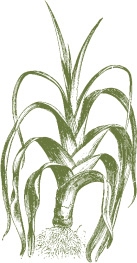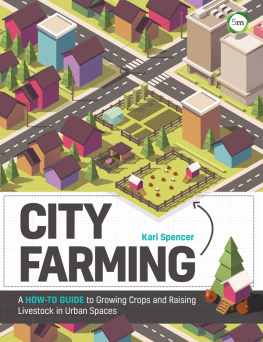YOUR FARM IN THE CITY
An Urban Dwellers Guide to Growing Food and Raising Livestock
LISA TAYLOR
AND THE GARDENERS OF Seattle tilth

CONTENTS
CHAPTER ONE
Down on the City Farm
CHAPTER TWO
Planning Your City Farm
CHAPTER THREE
Building Healthy Soil
CHAPTER FOUR
Raised Beds, Containers, and Vertical Planting
CHAPTER FIVE
Starting with Seeds
CHAPTER SIX
Soil Fertility
CHAPTER SEVEN
The Fruits and Vegetables of Your Labors
CHAPTER EIGHT
Keeping It Growing
CHAPTER NINE
Loving Your Enemies
CHAPTER TEN
Extending the Harvest
CHAPTER ELEVEN
Urban Farm Animals
CHAPTER TWELVE
Resources
DEDICATION
For Joan and Alwyn, you are the reason I grow vegetables.

DOWN ON THE CITY FARM
MY JOURNEY AS A CITY farmer began with a visit to a garden unlike any Id ever seen. A riot of color and activity, it was filled with bugs, creative trellises, and cool garden art. Fruits and vegetables were tucked among perennial herbs and shrubs, rather than in long, straight rows. Not only was it peaceful and inspirational, this garden was educational! Everywhere I looked were signs and demonstrations about how I could grow food at home and help the environment by gardening organically.

Located on a 12-acre city park, tucked behind formidable holly hedges, the original Seattle Tilth learning garden at the Good Shepherd Center in Seattle is an edible oasis in a frantic, bustling city. What a refreshing change to the monotony of lawns that predominate in urban and suburban landscapes. One visit and I was convinced: I wanted to create a mini-Tilth garden at my home. I envisioned a yard filled with vegetables and herbs, with fruit trees along the fence line and grapevines climbing an arbor over our porch swing. I wanted a place where I could pick my dinner just moments before it came into the kitchen. And thats exactly what I have now.
You can create a city farm, too! Described in this book are the simple, straightforward, and effective techniques that we have refined and taught at the Seattle Tilth learning garden for more than thirty years. Although my experience growing food and raising chickens has been in Seattle, the techniques described in this book can be used to create a high-yield city farm across the United States and Canada.
Well help you learn how to grow your own food and keep small livestock, such as chickens, goats, or bees. Youll explore how to grow food in a variety of urban settings, such as backyards, patios, balconies, and community gardens. With a little reading and a lot of effort, youll turn your boring, nonproductive space into a beautiful, diverse, food-producing city farm. So lets get started.
Good Food NOW!
We can thank the good food crusaders for this renewed interest in urban food productionAlice Waters, Michael Pollan, Jamie Oliver, Frances Moore Lapp, Barbara Kingsolver, and the slow-and local-food advocates. These modern-day good food evangelists honor the work of the organic movement founders, those smart, brave folks who always questioned the industrialization and mechanization of agriculture. Pioneers, such as Rudolf Steiner, Lady Eve Balfour, Sir Albert Howard, Masanobu Fukuoka, Alan Chadwick, and J. I. Rodale, recognized almost immediately how inappropriate the industrial, human-made model was when applied to a natural system. Documentaries, including Food Inc., Jamie Olivers Food Revolution, and Eric Schlossers Fast Food Nation are opening more eyes to the perils of the disconnect between people and their food. Even Oprah Winfrey has featured good food advocates several times on her show. For the first time since Eleanor Roosevelt, there is a vegetable garden in the White House lawn!

What Is Urban Farming?
Urban farming is a new term for growing a kitchen garden (or, to use the French term, potager) which has been practiced since the advent of cities. Previously, these efforts were called everything from pea-patching to victory gardening to edible landscaping. For our purposes, urban farming is defined as resourceful food gardening in a city setting and farmers are those nobly growing food for themselves, their families, and their community. Unlike the back-to-the-land movement of the 1970s, this new wave of urban farming isnt about giving up the city life and heading back to the farm but about embracing the notion of the little family farm in the big city.
The recent surge of interest in eating locally has inspired city dwellers to see food growing potential all around them. A grassy lawn with a southern exposure is a wasted opportunity for self-reliance and independence. Those front yards are perfect farmsteads. In fact, any patch of ground (whether it is covered by grass or pavement) that gets six to eight hours of sunlight and has access to water is a potential urban farm. In formerly vacant lots, it is now common to hear the exuberant clucking of laying hens or to smell the sharp tang of raised-bed herb gardens.
So whether you have a small patio or a quarter-acre, you can grow good food close to home; practice organic farming techniques that improve the environment; and make productive urban lands that currently provide little benefit for people. Plus, if you are brave and municipal zoning laws allow it, you can expand your farm to include livestock, such as chickens, bees, goats, ducks, and rabbits.
For many people, the goal is to grow healthy food, close to those who will eat it, and to have control over how it is grown. Others want their kids to forge a connection with nature and to know that their food doesnt come from boxes on the supermarket shelf. For those with more space, city farming makes produce available to communities that have no source of fresh foodespecially inner city food deserts. Farming in the city also fulfills the basic need for people to connect with growing things and the life force of our planet.
The aim of this book is to teach you how to grow food, but it is also about eating. Linked inextricably with city farms is the culture of preparing and preserving fresh food. By farming, you are becoming part of your local food system, following your food from seed to table to compost pile. So as you plan your farm, start first with what you love to eat. For me, there is nothing finer than lounging in the backyard, listening to songbirds, and reaching up to pick a few raspberries right off the vine and pop them al fresco into my mouth!
Why Grow Your Own Organic Food?
The organic urban farm: More than a source of sustenance
Next page











